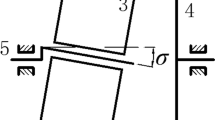Abstract
Six-axis numerical control spiral bevel gear grinder was taken as the object, multi-body system theory and Denavit-Hartenberg homogeneous transformed matrix (HTM) were utilized to establish the grinder synthesis error model, and the validity of model was confirmed by the experiment. Additionally, in grinding wheel tool point coordinate system, the errors of six degrees of freedom were simulated when the grinding wheel revolving around C-axis, moving along X-axis and Y-axis. The influence of these six errors on teeth space, helix angle, pitch, teeth profile was discussed. The simulation results show that the angle error is in the range from −0.148 4 rad to −0.241 9 rad when grinding wheel moving along X, Y-axis; the translation error is in the range from 0.866 0 μm to 3.605 3 μm when grinding wheel moving along X-axis. These angle and translation errors have a great influence on the helix angle, pitch, teeth thickness and tooth socket.
Similar content being viewed by others
References
SHIH Y P, FONG Z H. Flank modification methodology for face-hobbing hypoid gears based on ease-off topography [J]. Journal of Mechanical Design, 2007, 129(12): 1294–1302.
LIN C Y, TSAY C B, FONG Z H. Computer-aided manufacturing of spiral bevel and hypoid gears with minimum surface deviation [J]. Mech Mach Theory, 1998, 33(6): 785–803.
LIN C Y, TSAY C B, FONG Z H. Computer-aided manufacturing of spiral bevel and hypoid gears by applying optimization techniques [J]. Journal of Materials Processing Technology, 2001, 114: 22–35.
FAN Sheng-bo, WANG Tai-yong, WANG Wen-jin, WANG Wen-jin, LENG Yong-gang. Prediction of diameter errors compensation in bars turning [J]. Journal of Central South University of Technology, 2005, 12(S2): 264–268.
LEI W T, SUNG M P. NURBS-based fast geometric error compensation for CNC machine tools [J]. Inter Mach Tools Manufact, 2008, 48: 1199–1213.
SRIVASTAVA A K, VELDHUIS S C, ELBESTAWIT M A. Modeling geometric and thermal errors in a five-axis CNC machine tool [J]. Inter J Mach Tools Manufact, 1995, 35(9): 1321–1337.
LIN Y, SHEN Y. Modeling of five-axis machine tool metrology models using the matrix summation approach [J]. The International Journal of Advanced Manufacturing Technology, 2003, 21: 243–248.
BOHEZ E L J. Compensating for systematic errors in 5-axis NC machining [J]. Computer-Aided Dsign, 2002, 34: 391–403.
OKAFOR A C, ERTEKIN Y M. Derivation of machine tool error models and error compensation procedure for three axes vertical machining center using rigid body kinematics [J]. Inter J Mach Tools Manufact, 2000, 40: 1199–1213.
LEE J H, YANG S H. Measurement of geometric errors in a miniaturized machine tool using capacitance sensors [J]. Journal of Materials Processing Technology, 2005, 165: 1402–1409.
YANG Hong, NI Jun. Dynamic neural network modeling for nonlinear, nonstationary machine tool thermally induced error [J]. Inter J Mach Tools Manufact 2005, 45: 455–465.
YANG Hong, NI Jun. Adaptive model estimation of machine-tool thermal errors based on recursive dynamic modeling strategy [J]. Inter J Mach Tools Manufact, 2005, 45: 1–11.
ZHAO Hai-tao, YANG Jian-guo, SHEN Jin-hua. Simulation of thermal behavior of a CNC machine tool spindle [J]. Inter J Mach Tools Manufact, 2007, 47: 1003–1010.
FLORUSSEN G H J, DELBRESSINE F L M, VAN DE MOLENGRAFT M J G, SCHELLEKENS P H J. Assessing geometrical errors of multi-axis machines by three-dimensional length measurements [J]. Measurement, 2001, 30: 241–255.
TONG Heng-chao, YANG Jian-guo, LIU Guo-liang, WANG Xiu-shan, LI Yong-xiang. The volumetric error modeling technique of the two-axis system in an NC lathe [J]. Journal of Shanghai Jiaotong University, 2006, 40(7): 1213–1217. (in Chinese)
Author information
Authors and Affiliations
Corresponding author
Additional information
Foundation item: Project(2005CB724104) supported by the Major State Basic Research Development Program of China; Project(1343-77202) supported by the Graduate Students Innovate of Central South University
Rights and permissions
About this article
Cite this article
Chen, Sh., Yan, Hz. & Ming, Xz. Analysis and modeling of error of spiral bevel gear grinder based on multi-body system theory. J. Cent. South Univ. Technol. 15, 706–711 (2008). https://doi.org/10.1007/s11771-008-0131-7
Received:
Accepted:
Published:
Issue Date:
DOI: https://doi.org/10.1007/s11771-008-0131-7




